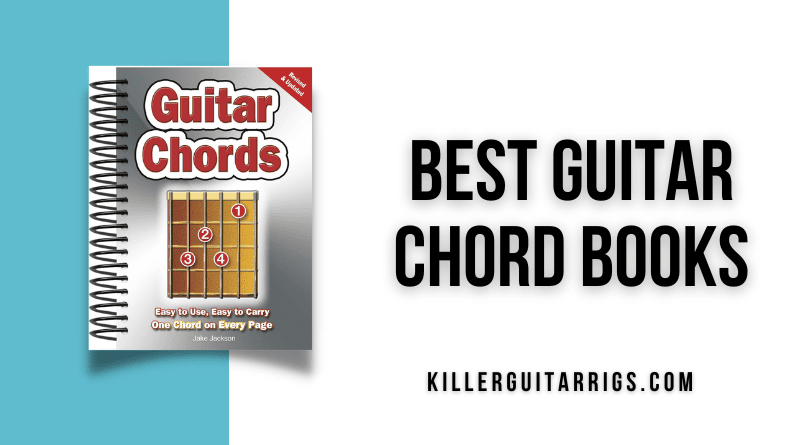Despite the fact that we’re living in an age in which we can pull up every chord imaginable on our cell phones, there’s still something special, and eminently practical about having a printed book of chords to reference against. Chord books are always there for you, they don’t need to be recharged, and are written in the same, consistent, easy to read format throughout.
Having a chord reference book is great for everyone from beginners looking to learn, to songwriters looking for interesting inversions and other ways to make their pieces sound more ear pleasing.
There are loads of chord books out there, and the methods they use are also varied, so you’re sure to find one that suits you. In this KillerGuitarRigs Review, we’ll be showing you our favorite chord books, picked for their readability, and the quality of information within.
If you’ve been thinking of buying a chord reference book, you won’t want to miss this definitive guide.
Read more about our review process.
Our Top Picks
The Guitar Chords book is our Top Pick for this list. This is an effective and convenient tool for learning chords that is easy to carry and features a great variety of examples.
Guitarists looking for an affordable book should check out our Best Budget option, the Hal Leonard Pocket Guitar Chord Dictionary. This book features 58 chord qualities and four voicings for each chord, making it a comprehensive chord guide for guitarists of all levels at a great price.
If you want top-quality and are willing to spend a bit more to get it, take a look at our Editor’s Choice, the Gig Bag Book Of Picture Chords For All Guitarists In Color. This book comes with accurate visual representations of chords, color-coded and with real pictures, making it super easy to visualize the finger positions required for each chord.
Individual Reviews
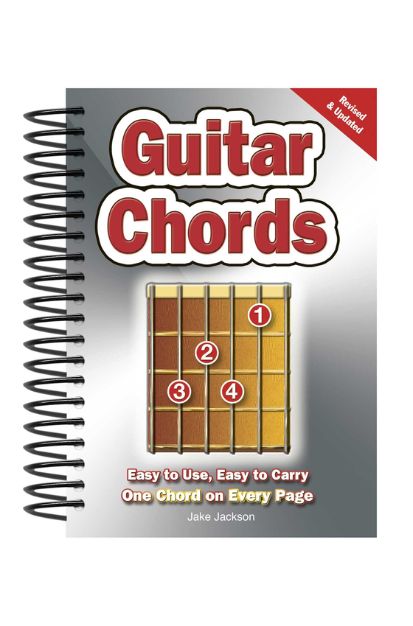
Guitar Chords
A simple, effective, and handy chord guide.
This is a straightforward book with a simple design and overall approach. You get one chord per page, in a giant diagram. The Guitar Chords book is a good resource for beginners that want to learn a good amount of chords in the most basic way possible.
The Guitar Chords Book is an effective and convenient reference for learning chords. This book is easy to carry, and will easily fit into a gig bag pocket, backpack, flight case, or purse, making it easy to have around, so you can prop it open at any given time.
We liked the basic premise of this book of providing nothing more than a chord diagram on each page. The book features one chord per page, making it really easy to establish goals such as learning one chord per day. This made it easy to read from a distance, for example, when propped up on a table, allowing us to practice each chord without having to be too close to the page.
Additionally, this is also a good resource to check out other voicings or different ways to play a chord.
With 360 chords written out, we had a lot of fun checking out different ways to play everything from basic triads, all the way to complex extended chords. This book can be a great asset for beginners, as well as a good tool to have around for more experienced players.
Naturally, 360 chords are a lot, but the secret is that most of them are just different voicings that can significantly help you expand your understanding of harmony.
Verdict: The Guitar Chords Book comes in a very straightforward fashion, organized with just one chord per page. This is a good reference for beginners as well as mid-level players that want to expand their voicings knowledge. Easy to carry and durable, this book is great to have around as a reference for many years to come.
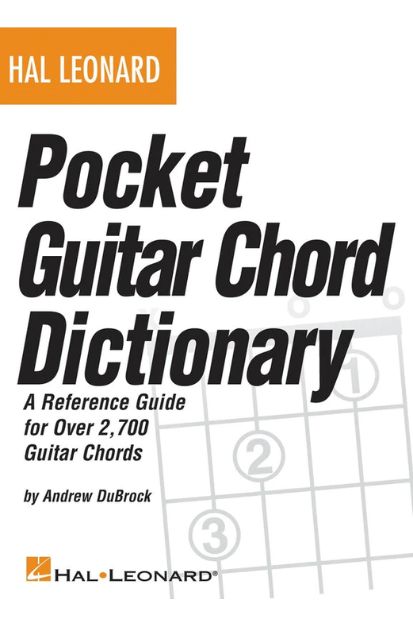
Hal Leonard Pocket Guitar Chord Dictionary
A convenient and reliable guide for students.
This is a fantastic reference guide that features over 2,700 guitar chord diagrams, making it one of the most comprehensive on the market. At just 4 x 6 inches, it’s super compact, and is a nice guide to always keep around for quickly checking out a new voicing, as well as a valuable tool for beginners starting to learn chords.
The Hal Leonard Pocket Guitar Chord Dictionary features an impressive 58 chord qualities and four voicings for each chord, making it a comprehensive yet convenient chord guide.
The organization of the book made it really easy to navigate, going by the letter of each chord and then giving us different qualities and four voicings for each. For instance, for all D chords, we got everything from D major to D7b5 (also known as half-diminished). We loved getting four different voicings for each chord quality, as these helped us to review the ones we knew and expand our knowledge with some we didn’t already know.
For instance, we were able to refresh our knowledge with the four different voicings of D7#5, also known as augmented seventh chords. This is a great tool to have not only as a guitar player but also for songwriters that may want to spice up their songs with more unconventional voicings. This fact alone makes this book a good buy, especially at such a low price.
Another aspect that we particularly liked about this book was that it started out by explaining some basic concepts in easy to understand language. In other words, it is a great choice for beginners who want a simple but complete start in learning and understanding what chords are and how they work.
Verdict: The Hal Leonard Pocket Guitar Chord Dictionary is an affordable resource for beginners to get started with chords. It features an impressive 2700 chords and 58 chord qualities. With this book, you will be able to understand how chords work and how to alter them in order to expand your knowledge and understanding of this fascinating subject.
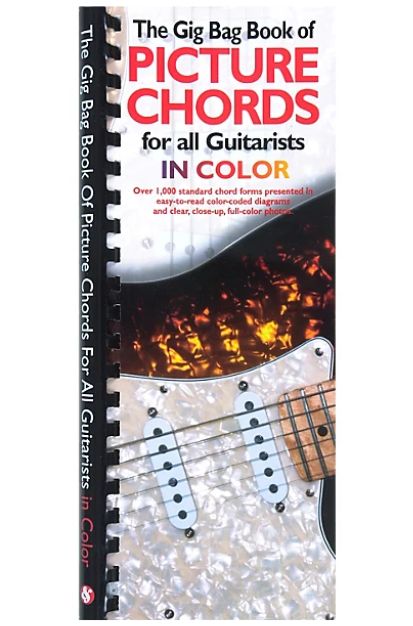
Gig Bag Book Of Picture Chords For All Guitarists In Color
A uniquely visual approach to chord learning.
This book contains easy-to-read and color-coded chord diagrams with full-color photos, so you truly see and understand the chord you are working on. Published by the iconic Hal Leonard LLC company, this chord book fits on your back pocket, gig bag or even in your hand, providing a valuable chord resource book that is also convenient.
This book contains easy-to-read and color-coded chord diagrams with full-color photos, so you truly see and understand the chord you are working on. Published by the iconic Hal Leonard LLC company, this chord book fits on your back pocket, gig bag or even in your hand, providing a valuable chord resource book that is also convenient.
The Gig Bag Book Of Picture Chords For All Guitarists In Color is a brilliant choice for any guitarist who wants an accurate visual representation of chords. Color-coded and with real pictures. This book is also a great option for younger players that may be easily bored with a typical chord book with unappealing diagrams, or for visual learners who need clear images to truly grasp concepts.
It came with over 1000 chords, far more than the average player will ever need to learn! We played through many of its pages and liked how the book followed a linear progression that allowed us to see the connection from one chord to the other.
The Gig Bag Book Of Picture Chords For All Guitarists In Color essentially laid down a strong foundation for the reader to seamlessly understand how chords work together. Take for instance an Am and an Am7 chord. This book clearly highlighted the difference between those two chords is just one note, and that even though they technically are different chords, they are more alike than most beginners would assume.
This book was very well written and small enough to fit just about anywhere, from your gig bag or backpack all the way to your back pocket. It is a great book to have around to review or check out any doubts you may have about a chord, and also a fantastic resource for beginners to learn chords in a progressive fashion.
Verdict: The Gig Bag Book Of Picture Chords For All Guitarists In Color is a fantastic visual resource for learning chords progressively. Besides being color-coded, this book is very well organized and structured to make sure the reader moves step by step, building a solid understanding of what chords are and how they work.
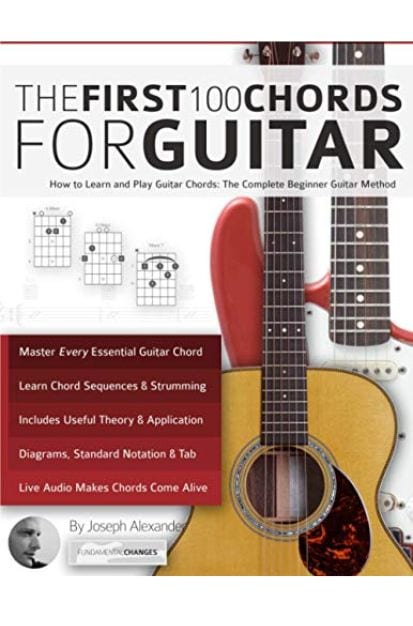
The First 100 Chords for Guitar
A simple approach to learning chords.
This book gives you 100 chords and complete information on how to fret, strum and combine these chords. In other words, instead of having thousands of chords, you get well beyond the most common ones and add valuable information to truly learn how to use chords in several useful and real-life contexts.
The First 100 Chords for Guitar flips the script of offering a staggering amount of chords and instead gives the reader just 100 (which is plenty!) and adds context on how to use them.
We loved how this book was organized, not by chord letters but by chord families. This took us down a more logical and progressive path of developing a true understanding of what chords are and how they work in harmony.
The first chapter of the First 100 Chords for Guitar focused exclusively on open chords, which are the easiest and most common, especially for beginners. From there, it started building further, moving from open chords to Dominant Seventh chords, barre chords and others.
One of our favorite aspects of this book was that it talked about music theory in an easy and comprehensible way. Although the thought of learning a bit of music theory is a turnoff for some, the First 100 Chords for Guitar does not shy away from it. In the end, the one that benefits from this is the reader, as he or she will understand and apply chords musically and in a smarter way.
Another aspect that we loved about this book is that it even delves into piano voicings, and how to apply this concept in the guitar. This was one of our favorite chapters, as it gave us a different and even daring way to explain chords and make them relatable to music in general and not just the guitar.
Naturally, after the first three chapters, this book may become a bit too intimidating for beginners. However, it is a good option for really dedicated players that are not afraid to dedicate serious time to learning chords the right way.
Verdict: The First 100 Chords for Guitar is a really good book for guitarists that are not afraid to go well beyond just learning how to finger chords. In this book, the reader gets music theory, ideas on how to practice and even piano voicings applied to the guitar. In short, a great book for disciplined guitarists that can put in the required time to master this topic.
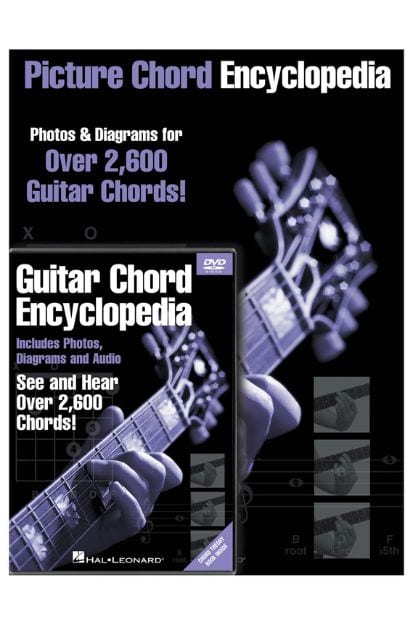
Picture Chord Encyclopedia
A vast and well-illustrated chord book.
This is a good book for guitarists that want not only plenty of chords and shapes but also a greater understanding of how these can be employed. Written in simple language, there are chapters that will help you understand how to form chords and how they work as well.
The Picture Chord Encyclopedia featured an impressive 2,640 chords, which are divided into 44 chord qualities covering all twelve keys. The name “Encyclopedia” was quite appropriate for this book, as it came with 264 pages that provide illustrated chords, diagrams, and even an actual photo of the chord being taught.
We liked that this book was well organized and structured, offering chapters based on the level of difficulty. Everything from open chords, triads, barre chords, and seventh chords was covered. This is a great start for any beginner who wants a solid knowledge of chords.
Additionally, the Picture Chord Encyclopedia had a dedicated chapter for extended chords, which is often a misunderstood topic, especially among beginners. This book demystified extended chords and explained it in plain English – not an easy feat to accomplish! We felt that even someone who is just starting out would be able to understand this chapter once that person has worked on the previous ones.
Another great chapter in this book dealt with inversions and voicings. The concept of inversions is quite simple once you understand how chords work, and the Picture Chord Encyclopedia did a good job of explaining them clearly.
Beyond just studying chords and voicings, this book started out by clarifying a few concepts that may elude some beginners otherwise. Take for instance the section on chord construction. Here, this book answers questions like “What is a chord” and “How does a chord get its name”. Both of these will provide a crucial understanding of chords and will bridge the gap between being able to play them and truly understanding them.
The one thing we did not like is that this book was organized chromatically. In other words, after the concepts of chord construction are explained, the Picture Chord Encyclopedia then features chords that move up by half step in each chapter. We felt that organizing it by the most common keys, or any other most-used type of structure would have been preferable.
Verdict: The Picture Chord Encyclopedia comes with well over two thousand chords with dozens of qualities and in all twelve keys. Besides being very clearly written, with illustrated chords, diagrams, and even chord photos, this book also provides great insight into how chords work.
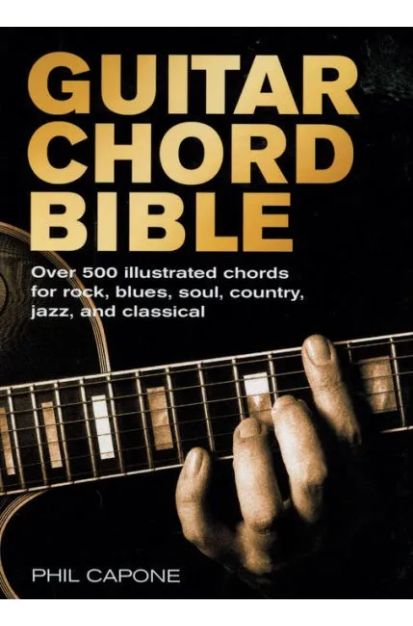
Guitar Chord Bible
A user-friendly reference for guitarists of all levels.
The Guitar Chord Bible features over 500 chords and is a portable, and user-friendly chord reference guide. This book is a great resource for guitarists of any musical style and features clear and color-coded chord diagrams to make it as easy as possible for the reader.
The Guitar Chord Bible provides the reader with unequivocal visual instructions for playing more than 500 chords. This book did a great job of illustrating chord variations all across the fretboard in order to provide the reader with a more complete understanding of how chords are built.
The Guitar Chord Bible was organized by ascending keys that move chromatically from C to B. One thing that made this book stand out was that it featured a chapter that talked about chords as they relate to specific genres. Specific voicings for rock, blues, soul, country and jazz, were addressed, too. Naturally, you can use any voicing for any style, but there are characteristic chords that are commonly found in certain genres.
We also found this book to be a good choice for students and guitarists that want a handy chord reference guide. With a compact format that we found fit anywhere easily, and color-coded fingering diagrams that allowed the user to have a better and quicker understanding of how to finger chords, this book was as effective as it was practical.
Unfortunately, just as with the Picture Chord Encyclopedia, the chromatic arrangement of the chapters wasn’t always the most logical path through the book, and as such it makes a better reference than it does a guide.
Verdict: The Guitar Chord Bible offers easy to understand visual instructions for more than 500 chords. Well written and convenient, this book is a good chord reference and will be especially useful for beginners that need step by step guidance on all the basic aspects that relate to chords, their formation and how and when to use them.

Guitar Chord Master
A great choice for learning chords in context.
This book deals with the inconvenient fact that a chord diagram does not teach a student how to actually play chords in context. Guitar Chord Master will go well beyond teaching you how to finger chords, as it also gives you strum patterns, giving you a musical context in which to use the chords you are learning.
The Guitar Chord Master book bridged the gap between learning chords and actually playing them in context. After all, knowing dozens of unrelated chords but never playing them in a musical situation is not that much fun.
We loved how this book was organized, featuring smaller chunks of information in order for us to process them better. Take for instance Chapter 3, where the chord diagrams actually begin. Here the book talked only about G and Em, implicitly introducing the concept of the relative minor.
This was a simple but crucial element of this book. The relative minor is an important concept that links chords together. As a matter of fact, the only difference between G and Em is one single note, hence the power of the relative minor concept.
Later in the book, chords were also introduced in pairs, but instead of the relative minor, the concept of dominant and tonic were also introduced. For instance, the chapter on A and E7 established yet another crucial relationship between chords. Just like the relative minor principle, the dominant and tonic principle is widely used in songs and makes chords much easier to understand, especially in regard to how they work together.
As a result of this structure, we think this book is a great choice for beginners. However, it is also a valuable option for more experienced guitarists that are still to understand that chords are closely related, and they work together to create harmony. The only downside of this book is that it does not feature a vast amount of chords.
Verdict: The Guitar Chord Master gives context to the concept of chords by introducing them not one by one, but in relationship to another chord. This creates a deeper understanding of how chords work and how they are applied in music, making it easier for guitarists to remember and use them effectively and in context.
How to Pick the Right Book For You
A goodchord book that is well-structured and comprehensive can be an invaluable resource, for anyone that wants to progress on guitar. Below we share a few pointers on what to look for in one.
Clear Diagrams
One of the key requirements for a good chord book is having clear and accurate chord diagrams. These diagrams visually represent the placement of fingers on the fretboard and should be easy to read. Typically, they come with lines representing each string and numbers indicating which finger to place on which fret.
The diagrams should be properly labeled and not too cluttered, allowing you to quickly understand and play the chords.
Comprehensive Content
Regardless of your personal musical preference, you’ll want a book that provides a wide range of chords, covering various types. These must include major, minor, dominant, suspended, augmented, diminished, and extended chords. Ideally you will also have chords displayed in different positions on the neck, so you can learn different voicings.
Music Theory
A chord book that incorporates basic music theory can significantly improve your understanding of chords. Look for a book that explains concepts such as chord construction, intervals, and the relationship between chords and scales. This knowledge will allow you to develop your chord vocabulary, come up with your own chord voicings, and even improvise over chord progressions.
Audio
Some chord books come with additional learning materials, such as online videos, online lessons, and audio tracks. These resources can be beneficial, as they provide greater context. Audio materials give you a more complete learning experience and can sweeten your understanding of chords, strumming techniques, and musical concepts.
Final Thoughts
A chord book will teach you a variety of chords, as well as how to build and use them. Additionally, it will give you some real-life context as well as audio examples. Ultimately, many of these books are very affordable, so it may actually benefit you to buy more than one in order to reap the benefit of different information.
To recap our favorites, the Guitar Chords book was our Top Pick for this review. This is an effective and convenient reference for learning chords that is easy to carry and features a great variety of examples.
Guitarists looking for a good guitar chord book at an extremely affordable price should check out our Best Budget option, the Hal Leonard Pocket Guitar Chord Dictionary. This book features 58 chord qualities and four voicings for each chord, making it a comprehensive chord guide for guitarists of all levels.
If you want top-quality and are willing to spend a bit more to get it, take a look at our Editor’s Choice, the Gig Bag Book Of Picture Chords For All Guitarists In Color. This book comes with accurate visual representations of chords, color-coded and with real pictures.

